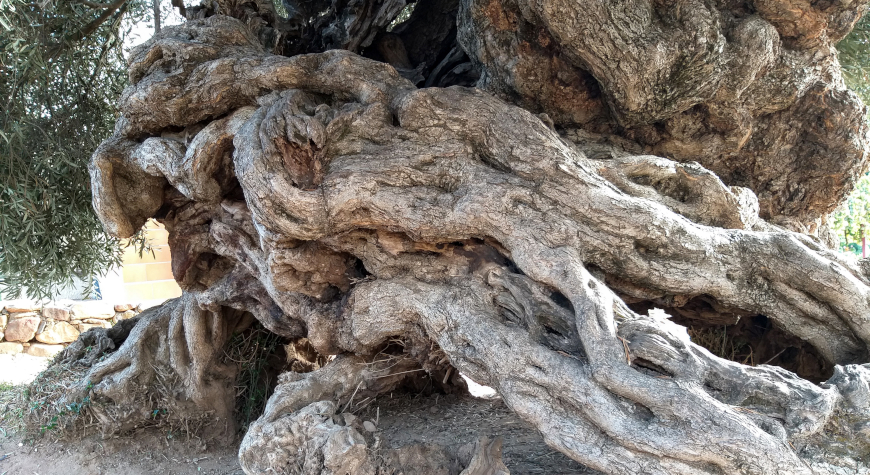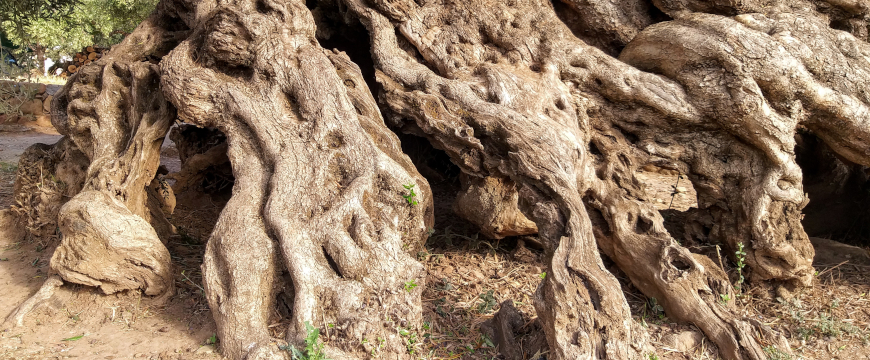Locals claim the ancient olive tree of Ano Vouves, Crete is the oldest olive tree in Greece. This may be an exaggeration, but at 3,000 to 5,000 years old, it is one of the oldest and most impressive. Although its huge trunk is now hollow, this tree still produces olives and entices tens of thousands of tourists to admire its sculptural beauty each year.

Following an ancient Greek tradition, some branches from this aged olive tree were used to make wreaths for Olympic marathon champions in 2004 and 2008; other branches from the tree were carried in the opening ceremonies in later years.

With its trunk more than 12.5 meters (41 feet) in circumference at its base, and over 4.5 meters (almost 15 feet) across, this tree has been designated a protected natural monument by the government and a Monumental Olive Tree by the Association of Cretan Olive Municipalities (SEDIK).

I first encountered this remarkable tree in 2015, as part of my initial exploration of the Greek olive oil world. I recommend that everyone interested in olives and olive oil who lives in or comes to the Chania area in northwest Crete head to the village of Ano (Upper) Vouves to see this monumental tree.

I have now visited the tree more times than I can count, with a Greek olive oil expert, a group of Princeton University alumni, and family and friends from the USA, Canada, Greece, and Germany. Whatever the season, we are likely to run into tourists from across the globe.

Each time I visit, I circle the tree in renewed fascination at the natural artistry of its giant hollow trunk, with its interwoven sections curving, bulging, and opening like abstract art depicting a sea creature or a science fiction invention, embracing the now-empty heart in a slowly growing dance that has continued for millennia.

Each time I witness the miracle of this tree’s continuing production, the details of its texture and form inspire me to add to my collection of hundreds of photos from all angles. Check out the fascinating 3D virtual tour of the interior of this hollow tree by another photographer that allows us to look around and up from inside the trunk.

Next to the monumental tree, there is a small museum (in two buildings, with a one euro entrance fee) displaying traditional farming implements, giant ceramic containers once used to hold olive oil, old-time photos, and fossilized olive leaves from Santorini that date back 37,000 to 50,000 years.

Also notice a second ancient olive tree near the road, and low bushes in the shape of the Olympic rings between the two ancient trees. Below the adjacent café, you can see an old-fashioned olive press and the type of millstones traditionally used to press olives to produce oil (generally replaced by modern machines today).
If you would like to see a stone mill and olive press that are still used, Biolea is a short drive away. You can also visit two modern olive mills in the area: Terra Creta and Anoskeli (the latter both an olive mill and a winery). These companies all welcome tourists for tours and tastings, at least during part of the year; see their websites to make appointments for a visit.
A scientist has provided more data about the ancient olive tree of Vouves.
All businesses, organizations, and competitions involved with Greek olive oil, the Mediterranean diet, and/or agrotourism or food tourism in Greece, as well as others interested in supporting Greeks working in these sectors, are invited to consider the advertising and sponsorship opportunities on the Greek Liquid Gold: Authentic Extra Virgin Olive Oil website. The only wide-ranging English-language site focused on news and information from the Greek olive oil world, it has helped companies reach consumers in more than 220 countries around the globe.


